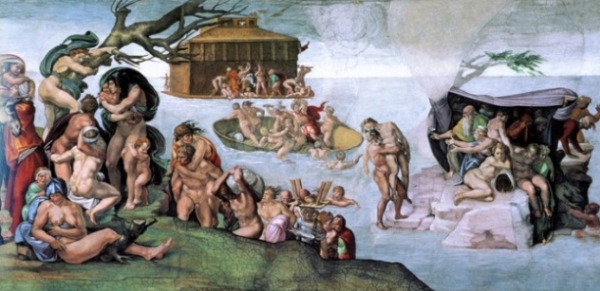이효섭 HEC Paris MBA/Sciences Po 정책학석사 복수학위 과정
[에듀인뉴스] 소프트웨어, 코딩을 넘어 인공지능까지. 빅데이터를 중심으로 한 응응 기술의 발전이 교육에 새로운 시대를 열고 있다. 에듀인뉴스는 ‘이효섭의 Tech 인사이트’를 통해 최신 기술 동향과 역사 간 접점을 찾아 새로운 기술의 개념과 응용 예시를 보다 쉽게 소개하고자 한다. 이번 연재는 어학 공부에 도움을 주기 위해 영문도 함께 제공한다.

사십 일 밤 동안 비가 내리더라
“지금부터 칠 일이면 내가 사십 주야를 땅에 비를 내려 내가 지은 모든 생물을 지면에서 쓸어버리리라”-창세기 7:4 (개역개정)
'대홍수'를 뜻하는 영단어 Deluge는 '씻겨내다'라는 의미를 지닌 라틴어 diluere에서 유래하였다.
성난 신(神)들이 타락한 인간들의 세상을 물로 정화하는 내용의 대홍수 신화는 세계 각 문명마다 다양한 형태로 존재한다.
인류 최초의 기록된 홍수 신화는 기원전 1800년 수메르 문명의 길가메시 서사시이다. 당시는 세계의 많은 문명이 청동기 시대에 접어 들던 무렵이었다. 문명 발원지에서 다양한 부족 국가들이 연합하여 대규모 농업을 통해 제국을 건설하였으며 제국의 수도는 거대 도시가 되었다.
이런 역사적 흐름 속에서 인류는 국가적 단위의 인력을 동원한 전쟁과 자연을 다스리기 위한 대규모 공사를 통해 개인 차원을 초월한 조직적인 악(惡)을 실현할 수 있는 능력과 본성을 서서히 깨닫게 되었다.

누구를 위한 더 나은 세상인가?
분노한 대자연에 언젠가 씻겨 나가버릴 수도 있다는 두려움은 수천 년 동안 인류의 잠재 의식 가운데 자리 잡았다. 지속가능성 개념은 이러한 막연한 두려움보다 진일보하여, 자연과 인간과의 관계에 대한 보다 성숙한 고찰과 이해를 통해 발전하였다.
역사가들은 독일의 귀족 한스 칼 폰 칼로위츠 (Hans Carl von Carlowitz, 1645-1714)가 임업에서 지속 가능성 (독일어: Naachhaltigkeit)의 첫 개념을 정립하였다고 본다.
칼로위츠에 따르면 숲 전체가 황무지가 되는 것을 막으려면 나무가 자라는 것보다 빠른 속도로 목재를 수확해서는 안 된다.
물론 현대적 의미의 지속가능성 개념은 워낙 광범위한 까닭에 정밀하게 정의하는 것은 어려운 일이지만, 그 핵심은 지구가 지속적으로 생명체의 터전으로 존재할 수 있도록 인간과 생태계 사이의 균형을 찾는 것이다.
오늘날 지속가능성은 정부와 기업 모두에게 중요한 목표로 자리매김하였다. 2015년 유엔 총회는 8대 밀레니엄 개발 목표 (https://www.un.org/millenniumgoals/)를 보다 포괄적인 지속가능발전 목표 17개 (https://www.un.org/sustainabledevelopment/sustainable-development-goals/)로 발전시켰다.
이와 같은 변화는 과거에 개발 도상국 지원 위주의 체제에서 인류 모두가 지속 가능한 개발을 달성할 수 있도록 전 세계로 협력의 범위를 확대하였다.
UN의 지속가능발전목표는 "모두에게 보다 낫고 지속가능한 미래를 달성하기 위한 청사진"으로 설계되었으며 2030년까지 달성하는 것을 목표로 한다. 이미 유수의 글로벌 기업들이 매년 GRI (Global Reporting Initiative) 지침을 따라 환경, 사회 및 지배구조에 대한 지속 가능성 보고서를 작성하고 있다.
지속 가능성을 국가와 기업의 전략적 목표로 인식하고 적용하려는 범세계적 노력에는 측정 가능하고 달성 가능한 목표 설정, 실행 가능한 약속의 이행, 그리고 일관적이고 집중된 국제 협력이 포함된다.
기술과 지속 가능한 개발
기술은 지속 가능한 개발을 달성하는 데 중추적인 역할을 담당한다. UN 지속가능발전 목표 9번은 회복력 있는 사회기반시설 구축, 포용적이고 지속가능한 산업화 증진 및 혁신 촉진이며 이에는 기술의 역할이 필수적이다.
기술은 지속가능한 발전을 구현하는데 세 가지 중요한 열쇠를 쥐고 있다.
첫째, 기술은 더 정확한 측정을 가능하게 한다.
센서와 모바일 통신을 통해 구축된 IoT(Internet of Things) 인프라는 온실 가스 배출량 또는 미세 먼지 수준과 같은 주요 지표를 실시간으로 관측할 수 있는 수단을 제공한다.
데이터 분석을 통한 변수 간 상관 관계를 파악하고 환경 피해의 가장 큰 원인을 추적할 수 있게 된다.
둘째, 기술은 효율성을 향상시킨다.
산업 및 가전 제품의 에너지 효율 향상은 에너지 소비와 오염을 감소시킨다. 농업 및 대중 교통에 사용되는 동력 장치의 효율 향상은 토양 복원력을 높이면서 배출을 억제한다.
셋째, 기술을 통해 리스크를 더 쉽게 관리할 수 있다.
데이터를 주의 깊게 모니터링하고 전반적으로 개선된 생산 기술을 적용함으로써 대규모 오염 및 기후 변화의 영향에 더 능동적으로 대응할 수 있게 된다.

녹색 기술
물론 최근 기업과 정부가 지속가능성에 진지한 노력을 기울이고 있는 것은 사실이나, 기술의 발전은 항상 천연 자원을 소비하여 인간의 욕구를 충족하는 상품과 서비스를 방향으로 이루어져왔다.
이에 따라 일각에서는 지속가능발전이라는 용어가 모순적(oxymoron)이라는 비판이 제기되고 있다.
우리가 기술을 개발하는 이유가 보다 더 많은 것을 빠르게 소비하기 위한 것이라면, 환경파괴는 결국 피할 수 없는 것일까?
녹색 기술(Green Tech)이란 환경을 보호하거나 과거에 발생한 환경 파괴를 원상회복하기 위한 기술을 포괄하는 광범위한 용어이다. 초기에는 산업 활동에 불가피하게 수반되는 부정적 외부 효과를 줄이기 위한 고민에서 출발하였다가 점차 환경 친화적인 제품과 서비스를 창출하기 위한 더 적극적인 방향으로 발전해왔다.
녹색 기술에는 대체 에너지, 재활용 및 폐기물 관리 방법뿐만 아니라 LED 조명에 이르기까지 다양한 종류가 있다.
최신 기술이 적용된 풍력 및 태양광 발전 등 대체 동력원은 과거에 비해 유지 보수가 용이해지고 훨씬 경제적이게 되었다. 이로 인해 세계의 많은 화석 연료가 크게 가치를 잃게 되었다.
수소 동력 및 전기 모터의 개발과 개선은 일상 차량에서 화물선에 이르기까지 다양한 크기의 대중 교통 및 이동 수단에 혁명을 일으킬 것으로 전망된다.

자원 절약을 넘어서
인류의 경제산업 활동이 빠른 속도로 지구의 기후를 변화시키고 있는 지금, 환경을 보전하기 위한 노력은 단순히 천연 자원을 아껴 쓰는 것만으로는 충분하지 않다.
인간의 활동으로 인해 모든 생명체의 삶의 터전인 환경에 발생한 돌이킬 수 없는 피해는 기술의 본질에 대해 곰곰이 생각해볼 화두를 던지고 있다.
불행히도 우리의 생각보다 시간이 넉넉하지 않다. 범세계적인 협력과 적극적인 대응 없이는 지구가 항상성(homeostasis: 생태계 평형)을 유지할 수 있는 속도보다 빠르게 환경 파괴가 지속될 것이다.
다행히도 인류는 역사를 바꾸는 데 이미 한 차례 성공한 경험이 있다. 오존층 파괴의 주범으로 밝혀진 프레온 가스는 1987년 몬트리올 의정서를 통해 생산과 사용이 금지되었다.
그 결과 지구의 오존층은 1990년대 중반에 안정화되어 2000년대에 들어 서서히 회복되기 시작하였다. 몬트리올 의정서의 성공을 통해 얻은 교훈은 UN지속가능발전목표 17개를 달성하는 데 큰 힘이 될 것이다.
기술은 환경 문제에 대한 원인과 해답을 동시에 쥐고 있다. 고대의 신화적 대홍수는 인류의 죄악을 벌하는 신들의 분노를 상징하는 동시에 기술의 발전을 통해 자연을 다스리는 힘을 갖게 된 인간이 이에 대한 응보를 언젠가 치러야 할지 모른다는 무의식적인 두려움을 담아낸 이야기이다.
지속가능성은 더 이상 달성하지 못해도 그만인 부차적인 목표에 불과한 것이 아니다. 인류는 지속가능성을 범세계적이고 중요한 공동 목표 중 하나로 받아들임으로써 스스로의 행동에 대한 결과에 직면하고 홍수에 대한 막연한 두려움을 극복하는 매우 중요한 첫 걸음을 디뎠다.
관련 동영상
Noah's Ark and Floods in the Ancient Near East: Crash Course World Mythology #16
Crash Course by National Public Radio
https://www.youtube.com/watch?v=VA3j5_vKQfc
How we can make the world a better place by 2030, Michael Green TED Talks
https://www.youtube.com/watch?v=o08ykAqLOxk
And it rained for forty days and forty nights…
“Seven days from now I will send rain on the earth for forty days and forty nights, and I will wipe from the face of the earth every living creature I have made.” Genesis 7:4 (New International Version)
The English word ‘deluge’ comes from the Latin diluere, which means to wash away. In many parts of the world, we find many different stories of flood myths where angry gods destroy mankind by washing the world away with water. The earliest recorded version of the flood myth comes from the Sumerian Epic of Gilgamesh in the 1800 BC. Many civilizations around the world were entering the bronze age. Empires were built and supported through mass agriculture and their capitals became megacities. This also meant that humanity was waking up to their own capabilities and penchant for evil, not as an individual but as a collective force against each other and against nature they were beginning to tame.
A better world for whom?
The fear of being washed away by Mother Nature has been in humanity’s subconsciousness for millennia. A more refined version of our apprehension toward the relationship between man and nature evolved into the modern concept of sustainability. Historians credit the German nobleman Hans Carl von Carlowitz (1645-1714) with formulating the idea of sustainability (Naachhaltigkeit) from forestry. According to Carlowitz, you should never harvest timber at rates faster than trees grow lest the entire forest will eventually become barren. While it is challenging to define the broad concept of sustainability in precise terms, the central idea is to find an equilibrium between human existence and our ecosystem so that our planet will continue to support life.
Sustainability is an important goal for modern governments and businesses alike. In 2015, the United Nations General Assembly evolved the 8 Millennium Development Goals (https://www.un.org/millenniumgoals/) to 17 Sustainable Development Goals (https://www.un.org/sustainabledevelopment/sustainable-development-goals/) . This shift has expanded the scope of global cooperation from helping developing nations to the entire global community so that humanity may accomplish sustainable development. These global goals are designed to be a “blueprint to achieve a better and more sustainable future for all,” and are intended to be achieved by the year 2030. Many leading companies produce annual sustainability reports to disclose their environmental, social and corporate governance following Global Reporting Initiative (GRI) guidelines. Global efforts to incorporate sustainability as a strategic goal entail setting measurable and attainable targets, implementing actionable commitment as well as consistent, concentrated and orchestrated cooperation.
Technology and Sustainable Development
Technology plays a vital role in accomplishing sustainable development. UN SDG 9 is to build resilient infrastructure, promote inclusive and sustainable industrialization and foster innovation. There are three important ways technology holds the key to realize sustainable development.
First, technology enables better measurement.
Sensor technology enables IoT (Internet of Things) infrastructure, thus providing the means to monitor key metric such as greenhouse gas emissions or fine dust levels. Big data analytics allows us to identify correlation between variables and trace back the biggest culprit behind environment damage.
Second, technology improves efficiency.
Better energy efficiency in industrial and home appliances decreases both energy consumption and pollution. Increased motor efficiency in agriculture and public transport curbs emission while increasing soil resilience.
Third, technology makes it easier to manage risk.
By carefully monitoring data and applying improved production technologies across the board, we can counter or slow the effects of large-scale pollution and climate change.
Green Technology
Recent trends in sustainability notwithstanding, technological progress has amplified human abilities to consume resources to produce goods and services that meet their needs. As such, some criticize the term sustainable development to be oxymoronic. If the reason we develop technology is to consume more which inevitably causes irreparable damage to the environment, how can any development be inherently sustainable?
Green technology is a broad term to capture technologies that aim to protect the environment or even reverse the damage done in the past. Green tech has evolved from finding ways to reduce the negative externalities concomitant with industrial activity toward a more proactive direction to create products and services that are environmentally friendly.
Examples range from alternative energy, recycling and waste management, to LED lighting. Alternative energy sources such as wind and solar power have become exceedingly accessible and economic to construct and maintain. This has left many of the world’s fossil fuel reserves to lose their value. The development of hydrogen power and electric motors will revolutionize public transport and vehicles of all sizes from our everyday cars to cargo ships.
Thinking beyond conservation
Conserving natural resources alone is not enough when global human activities can potentially change the global climate at such rapid rates. Irreparable damage to our environment challenges us to rethink technology from the very start.
Unfortunately, there is less time than we think. Without a globally coordinated response, human activity will outpace the rate the planet can maintain homeostasis (equilibrium of the ecosystem), spelling out certain doom for everyone. Fortunately, we have recently succeeded in changing our ways. Freon gas which has been identified to be responsible for ozone depletion have been banned in the Montreal Protocol in 1987. As a result, Earth’s ozone levels have stabilized by the mid-1990s and began to recover in the 2000s. The lessons learned through the success of the Montreal Protocol will hopefully be replicated through the 17 UN SDGs.
Technology will continue hold both the answers and the causes of our problems with our environment. The ancient deluge represented a divine comeuppance for mankind’s sins as well as fear toward the unknown backlash from Mother Nature for humanity’s hubris to tame her. Sustainability is no longer a secondary bonus objective. By embracing sustainability as one of our primary goals, humanity has begun a very important step to face our fears head on deal with the consequences of our own actions.
Also watch
Noah's Ark and Floods in the Ancient Near East: Crash Course World Mythology #16
Crash Course by National Public Radio
https://www.youtube.com/watch?v=VA3j5_vKQfc
How we can make the world a better place by 2030, Michael Green TED Talks
https://www.youtube.com/watch?v=o08ykAqLOxk

이효섭 HEC Paris MBA/Sciences Po 정책학석사(Digital, New Technology and Public Policy) 복수학위 과정=고려대 법학과/경영학과를 졸업한 이효섭 씨는 전 국방부 국제정책관실 통역장교, 전 ㈜한국항공우주산업 KF-X 및 APT 사업 계약협상 담당과장을 지냈으며 Palantir Technologies 런던사무소 근무 예정이다.
"억지로 공부해서 대학도 가고 대학원도 왔지만, 공부하는 재미를 이제서야 깨우친 아저씨입니다. 한번에 읽히는 글, 진실이 담긴 글, 겸손한 글을 쓰기 위해 노력하겠습니다."

